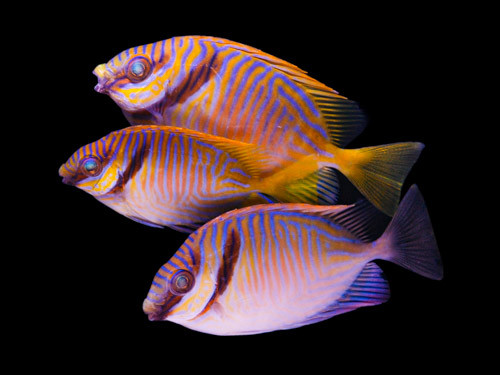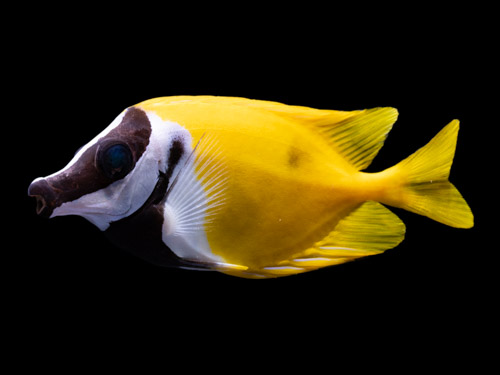The Rabbitfish: A Look at Several Siganus Species

Rabbitfish (Siganus sp)
Many species of Rabbitfish or Spinefoots, genus Siganidae, are often overlooked for inclusion in aquaria. Still, their unique appearances, utility in aquariums, and resilience make many of them beautiful inclusions. They are relatively peaceful and easy-going, earning candidacy for both reef aquariums and fish only tanks. The genus depending on whom you ask, contains twenty-five approximate species with a few hybrids. In this post, well talk about a few of the more commonly and less-commonly available species.
Siganus vulpinus
This species is the most widely offered of the Rabbitfish and is a marine aquarium staple, commonly called the Foxface. Its large availability is due to its wide distribution, which includes Indonesia, the Great Barrier Reef, as well as many other locales, including Tonga. Juveniles can be observed in large schools, grazing on algae and detritus within it, while adults prefer to be solitary or in pairs while mating. These look incredibly similar to Siganus unimaculatus, the one spot Foxface, which is also a standard offering.
Siganus doliatus
This Siganus has multiple common names, although the few we see most commonly used are the two-barred, scribbled, and blue-lined rabbitfish or Spinefoot. It, too, can be found in Indonesia as well as Australia and Tonga. It is, at times, confused for S. virgatus, another appropriate species for aquaria.
Siganus uspi
This species of rabbitfish is typically referred to as the bi-color Foxface for obvious reasons. One of the reasons aquarists favor this species over some of the other offerings, is that these stay relatively small, making them great for algae control in medium sized reef aquaria.
Siganus magnificus
The Magnificent Foxface is lesser seen in comparison to other typical offerings but is coveted for its brilliant silver hues by many collectors. Though harder to obtain due to its distribution, it makes for just as resilient as other species mentioned above.
Siganus guttatus
The Yellow Blotch Rabbitfish is not only a gorgeous fish but has behavioral traits that differ from other congeners. It is active at night and tends to inhabit brackish estuaries for longer periods than its relatives who usually only take rogue in these areas as juveniles.
Siganus argenteus
The streamlined rabbitfish gets its common name due to a more laterally compressed and aerodynamic profile in comparison to other members of the genus. Its also different from others discussed here in that it tends to continue to school as adults, about 14 species of rabbitfish do this. They prefer to feed almost exclusively on algae wheres as many other still intake other organic matter such as zooplankton. Its larger size and necessity to graze continuously makes it a candidate for large reef aquaria.
In The Home Aquarium
Rabbitfish have venomous dorsal spines for protection, as such though they remain peaceful some of them are candidates for inclusion in more aggressive aquaria as predators tend to give them a wide berth. This last statement is true for the aquarist as well, while Rabbitfish do not attack people; caution should be exercised when servicing an aquarium that contains them. This said, rabbitfish can still be skittish at times using camaflaouge which many aquarists refer to as a night or fright response, so youll want to make sure they have plenty of refuge and places to hide. Like tangs, they can quarrel with conspecifics, but given enough space and simultaneous introduction, this situation may work out. While many species of rabbitfish will include organic detritus and zooplankton int heir diet, their diet is mostly herbivorous and a quality pellet or Nutramar Nori should be offered daily if not multiple times a day.
